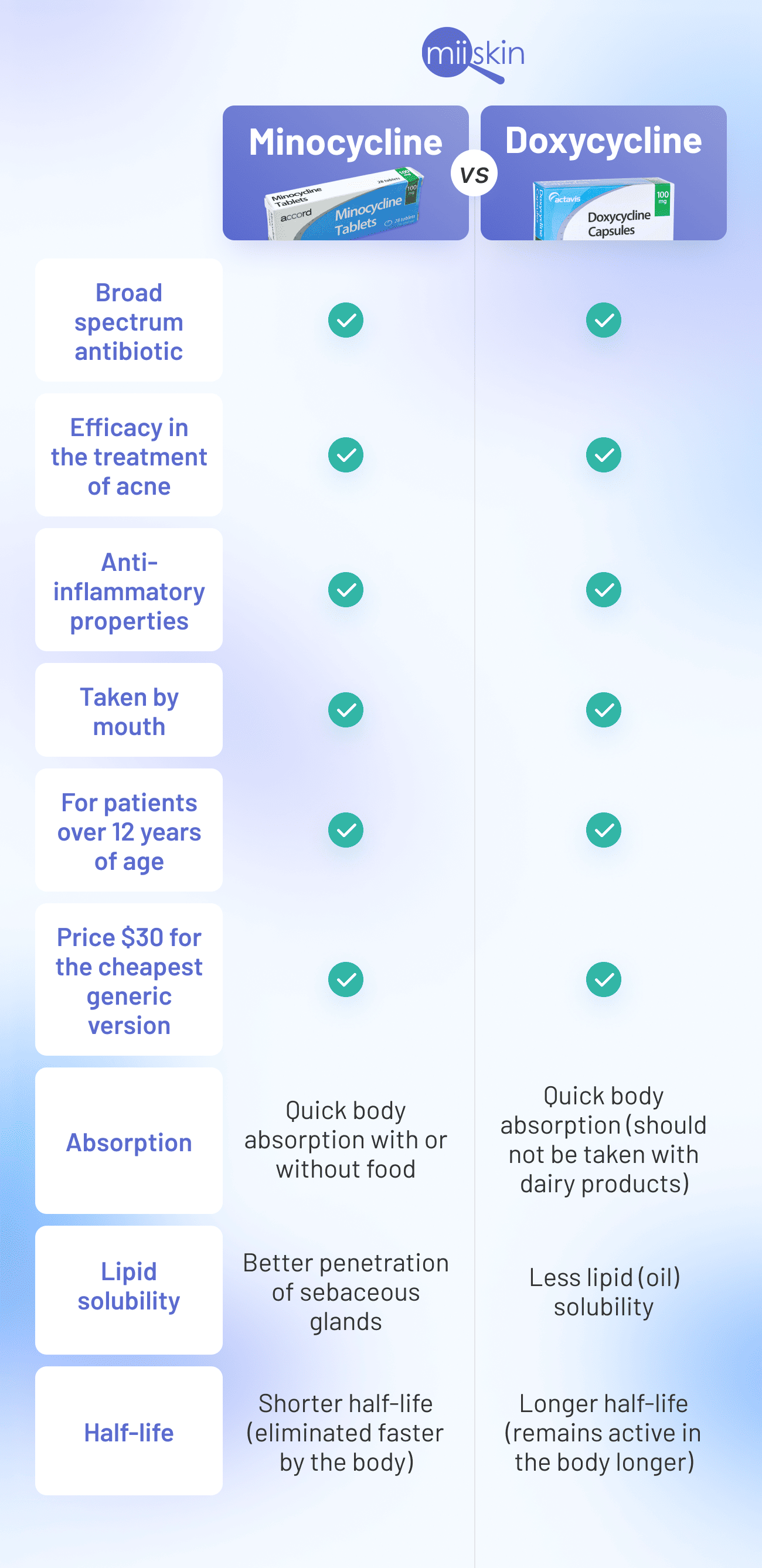The best time to take doxycycline for acne is typically once or twice daily, as prescribed by a healthcare professional, with a full glass of water and avoiding bedtime to prevent esophageal irritation. Always take doxycycline with food or following a meal to reduce stomach upset and enhance absorption.
Doxycycline, a commonly used antibiotic for acne treatment, can significantly improve skin condition when used correctly. Its effectiveness stems from its ability to reduce inflammation and bacterial growth. Dealing with acne requires a consistent treatment plan, and doxycycline plays a crucial role in many individuals’ regimens.
Patients are often advised to adhere to their doctor’s instructions, as the dosage and timing can vary based on the severity of the acne and the patient’s overall health. Ensuring proper intake of the medication can lead to optimal results and a clearer complexion. Always consult with a healthcare provider before starting any new medication to ensure it aligns with your specific health needs and to understand the potential side effects and interactions.
The Battle Against Acne
The fight against acne is a journey many undertake in search of clear skin. Acne, a common yet stubborn adversary, affects countless individuals. Navigating through treatment options can seem daunting. Yet, understanding when and how to use certain medications can turn the tide in this battle. One such ally in this fight is the antibiotic doxycycline.
The Role Of Antibiotics
Antibiotics serve as a powerful weapon against acne. They attack the bacteria that contribute to skin blemishes. They also reduce inflammation, which is a major part of acne. Not all antibiotics are the same. Each has a unique role in skincare.
- Target harmful bacteria: Antibiotics help to kill or slow down the growth of P. acnes bacteria.
- Reduce inflammation: They lessen redness and swelling associated with acne lesions.
- Complement other treatments: Often used alongside topical treatments for a more comprehensive approach.
Doxycycline’s Place In Acne Treatment
Doxycycline stands out as a preferred antibiotic for acne. It is known for its effectiveness and safety profile. It falls under the category of tetracyclines. This group is particularly good at fighting acne.
| Doxycycline Feature | Benefit |
|---|---|
| Anti-inflammatory properties | Reduces redness and swelling of acne |
| Bacteriostatic effect | Prevents bacteria from multiplying |
| Oral administration | Convenient for widespread acne |
For optimal results, take doxycycline as directed by a healthcare provider. The best time often aligns with your routine, ensuring consistency.
Remember, each individual is different. A dermatologist can provide the best guidance. They will consider factors like acne severity, other medications, and personal schedule. Their advice ensures doxycycline is both safe and effective for you.

Credit: miiskin.com
Doxycycline 101
Understanding how to tackle acne starts with knowing your options. Doxycycline is a popular choice. Let’s dive deep into Doxycycline’s world and see how it helps clear your skin.
What Is Doxycycline?
Doxycycline is an antibiotic. Doctors often prescribe it for bacterial infections. This includes skin troubles like acne. Unlike creams, you take it orally.
How Doxycycline Fights Acne
Doxycycline fights acne from the inside. It stops bacteria that cause acne. This helps reduce redness and swelling. Here’s how it works:
- Attacks Bacteria: It kills bacteria linked to acne.
- Reduces Inflammation: It lowers skin inflammation.
- Prevents Breakouts: Regular use can prevent new pimples.
For best results, follow your doctor’s advice on when to take Doxycycline. Stay patient as the medicine does its job.
Timing Matters
Understanding the best time to take doxycycline for acne can make a significant difference in your treatment. Doxycycline works systematically and following a routine enhances its benefits. The right timing can lead to optimal absorption and effectiveness.
Importance Of Dosage Timing
Doxycycline’s performance ties closely to its dosage timing. This medication works best when consistent levels are maintained in the bloodstream. Your doctor will likely recommend taking it at the same time every day. This consistency helps in managing acne more effectively. It’s not just about the day, but the hour that can influence your treatment’s success.
- Take doxycycline with a full glass of water to aid in absorption and protect the esophagus.
- Avoid taking doxycycline right before bed to prevent irritation of the throat.
- Meal timing can also play a role; some forms of doxycycline may require you to take them on an empty stomach or with food.
Impact Of Timing On Effectiveness
The timing of your doxycycline dose can affect how well the medication works. Incorrect timing may reduce its potency and the overall efficacy against acne. To maximize absorption:
| Timing | Reason | Benefit |
|---|---|---|
| Early in the day | Prevents lying down soon after | Enhances absorption |
| With meals | For types needing food | Reduces stomach upset |
| Apart from dairy | Calcium can hinder absorption | Ensures full effectiveness |
Some forms of doxycycline are more flexible with food, while others may require an empty stomach. Always follow your doctor’s instructions. Taking your medication in the right way ensures you get the full benefit in your fight against acne.

Credit: www.aad.org
Morning Or Evening?
Deciding whether to take doxycycline for acne in the morning or evening can be puzzling. Each option has its unique benefits and drawbacks. Understanding the pros and cons helps tailor your acne treatment to fit into your daily routine seamlessly.
Pros And Cons Of Morning Dosage
The morning dose of doxycycline offers several advantages.
- Boosts consistency: Integrating the pill into a morning routine may improve adherence.
- Less stomach irritation: Taking it with breakfast may reduce the risk of an upset stomach.
However, morning doses come with possible downsides.
- Sensitivity to sunlight: Doxycycline can increase sun sensitivity, posing a greater risk during the day.
- Interference with daily activities: If side effects occur, they may disrupt your day.
Pros And Cons Of Evening Dosage
Evening dosages align well with the body’s natural rhythms.
- Reduced sun sensitivity risk: Limited sun exposure after taking doxycycline reduces the chance of sunburn.
- Side effects during sleep: Potential side effects may pass unnoticed during sleep.
Evening doses also have limitations.
- Empty stomach issues: Taking doxycycline without adequate food might cause discomfort.
- Potential sleep disturbance: On rare occasions, it may affect sleep quality.
Food For Thought
Managing acne with doxycycline requires a thoughtful approach, especially when it comes to meals. Your body’s absorption of the medication can be influenced by what you eat. This section sheds light on the best practices for taking doxycycline to maximize its effectiveness against acne.
Taking Doxycycline With Meals
Doxycycline works best on an empty stomach. It’s recommended to take it 1-2 hours before or after meals. This timing ensures the most efficient absorption. Here’s a quick guide:
- Breakfast: Wait at least an hour after taking doxycycline.
- Lunch: Take the pill 2 hours before eating.
- Dinner: Ensure there’s a 2-hour gap post-meal.
Stay consistent with the time you take your medication daily. It helps your body maintain stable drug levels.
Foods To Avoid
Some foods can affect doxycycline’s effectiveness. Here’s a list of what to steer clear of:
| Food Type | Reason to Avoid |
|---|---|
| Dairy Products | Calcium can bind to doxycycline, reducing its absorption. |
| Iron Supplements | Iron can interfere with the effectiveness of the drug. |
| Alcohol | It can increase the risk of side effects and reduce drug efficacy. |
For the best results, check with your doctor about your diet while on doxycycline.
Interactions And Considerations
Understanding when to take Doxycycline for acne involves more than just timing. It’s crucial to consider the interactions and other factors that may influence its effectiveness. Let’s dive into the common drug interactions and other elements you should keep in mind.
Common Drug Interactions
Doxycycline works well for acne, but mixing it with certain drugs can be risky. Here’s a list of common medications to avoid:
- Calcium supplements: They may reduce Doxycycline’s absorption.
- Iron products: Similar to calcium, iron can hinder how well Doxycycline works.
- Antacids: Containing aluminum, calcium, or magnesium, they can also lessen Doxycycline’s effectiveness.
- Retinoids: Used for acne, but be careful, as combining them with Doxycycline can increase pressure in your brain.
- Blood thinners: Doxycycline might boost the risk of bleeding if you’re on these.
Always check with a healthcare provider before mixing Doxycycline with other treatments.
Other Factors Influencing Doxycycline Timing
Several non-drug factors also impact when you should take Doxycycline:
| Factor | Explanation |
|---|---|
| Food | Eating just before or after can affect absorption. |
| Sun Exposure | Doxycycline can make your skin more sensitive to sunlight. |
| Dairy Products | They can bind to the drug, making it less effective. |
For optimal results, take Doxycycline on an empty stomach with a full glass of water, and avoid direct sun exposure.
Personalized Schedules
The journey to clear skin is deeply personal, especially when it comes to treating acne with medications like doxycycline. Recognizing the importance of individual needs, personalized schedules for doxycycline intake can make all the difference. Tailoring the timing and dosage to your unique lifestyle and body’s responses enhances the effectiveness of the treatment.
Tailoring Your Regimen
Creating a doxycycline schedule that fits your daily routine is crucial. It should align with your meals, as some individuals may experience an upset stomach if the medication is taken on an empty one. Consider these factors:
- Meal times: Doxycycline is best taken with a full glass of water and after a meal to reduce stomach irritation.
- Daily activities: If you’re more active during the day, a morning dose may be preferable.
- Consistency: Taking your medication at the same time every day ensures steady levels in your body.
Consulting With A Dermatologist
A dermatologist is your best guide in crafting a doxycycline schedule. During the consultation, they will consider:
- Your acne’s severity.
- Any other medications you’re taking.
- Your medical history.
- How your body has reacted to past treatments.
Based on these factors, they will recommend a dosage and timing tailored to you.
Maximizing Treatment Success
Success in treating acne with doxycycline depends on the right timing and habits. This section explores how to maximize treatment efficacy.
Adherence To Prescribed Schedule
Taking doxycycline exactly as prescribed is key. The body maintains a consistent medication level this way. It’s not just about the day’s time; it’s about the consistency.
- Take your dose at the same time every day.
- Set reminders to avoid missed doses.
- Understand the duration of your treatment plan.
Lifestyle Adjustments For Better Results
Lifestyle can affect doxycycline’s success against acne. Here are adjustments for better outcomes:
- Avoid dairy close to your dose; it can interfere with absorption.
- Limit sun exposure; doxycycline can increase sensitivity.
- Keep a healthy diet; it supports overall skin health.
Remember, a holistic approach often yields the best results.
Beyond Timing: Complementary Strategies
Dealing with acne can be a challenge. Finding the best time to take Doxycycline is crucial, but there’s more to the story. Effective acne management often requires a holistic approach. Let’s explore how combining Doxycycline with other strategies can lead to clearer skin.
Topical Treatments And Doxycycline
Combining oral medications like Doxycycline with topical treatments can enhance results. The key is to use products that complement the antibiotic’s effects without causing irritation.
- Retinoids: Promote cell turnover and prevent clogged pores.
- Benzoyl peroxide: Kills bacteria and helps prevent antibiotic resistance.
- Salicylic acid: Helps clear pores and reduce swelling.
Always apply topical treatments as directed by a healthcare provider. They will help ensure the skin’s barrier remains healthy while Doxycycline tackles the bacteria from within.
Diet And Exercise
Healthy habits like a balanced diet and regular exercise can support your acne treatment plan. These habits reduce inflammation in the body, which can help calm acne flare-ups.
| Food Group | Benefits |
|---|---|
| Fruits and Vegetables | Rich in antioxidants and vital nutrients. |
| Lean Proteins | Builds and repairs skin tissue. |
| Whole Grains | Provides fiber, reducing inflammation. |
Regular exercise boosts circulation. This helps nourish skin cells and carry away waste products. Aim for at least 30 minutes of moderate activity most days of the week.
Monitoring Progress And Adjustments
Finding the best time to take doxycycline for acne is a journey. It’s vital to keep track of your skin’s response. Adjusting your routine can make all the difference. Let’s explore how to monitor your acne’s improvement and when to tweak your doxycycline schedule.
Tracking Your Acne Improvement
Seeing changes in your skin? That’s great! Tracking progress is key. Here’s how:
- Take photos: Snap pictures of your face in natural light. Do this weekly.
- Use an app: Many apps help log skin changes over time.
- Journal: Write down any flare-ups or improvements.
When To Consider Schedule Changes
Is your skin not getting better? After a few weeks, you might need a new plan. Talk to your doctor. They might change your dose or timing. Remember:
| Time on Doxycycline | Action |
|---|---|
| 4-8 weeks | Look for minor improvements. |
| 8-12 weeks | If no change, consult your doctor. |
| 12+ weeks | Possible dosage or medication change. |
Stay patient and keep in touch with your healthcare provider. Your clear skin journey is unique, and adjustments are part of the process.

Credit: www.theindependentpharmacy.co.uk
Frequently Asked Questions
Is It Better To Take Doxycycline In The Morning Or At Night?
Doxycycline can be taken either in the morning or at night, based on your doctor’s advice. Consider taking it with food to reduce stomach upset, and maintain a consistent schedule daily for optimal effectiveness.
What Should I Avoid While Taking Doxycycline?
Avoid taking doxycycline with dairy products, iron, or calcium supplements, as they can hinder absorption. Stay out of direct sunlight and UV rays to prevent skin sensitivity. Do not consume alcohol as it may worsen side effects. Avoid taking expired doxycycline to prevent kidney damage.
Does Doxycycline Actually Clear Acne?
Yes, doxycycline can help clear acne by reducing bacteria and inflammation. It is an effective treatment often prescribed by dermatologists.
How Long Is The Purging Stage Of Acne On Doxycycline?
The purging stage of acne on doxycycline typically lasts 2-6 weeks. Individual experiences may vary depending on skin type and severity of acne.
Conclusion
Navigating the timing for doxycycline in acne treatment can be nuanced. Your dermatologist’s guidance is key for optimal results. Typically, taking the medication on an empty stomach, either in the morning or evening, proves effective. Remember, consistency and patience are vital as improvements can take several weeks.
Always consult a healthcare professional before starting any new medication regimen.

